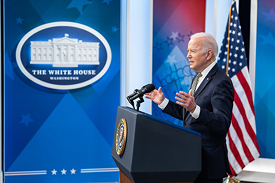Total number of posts 454.
 The Indo-Pacific Economic Framework for Prosperity (IPEF), an economic strategy proposed by the US, is a new attempt to revise the connection between the US and Asia-Pacific countries. As an open framework, the success of IPEF is still open to question as there are no trade provisions or potentially reduced tariffs for commercial activities. As such, the participation of Vietnam is largely dependent on the outcome of discussions and implementation.
The Indo-Pacific Economic Framework for Prosperity (IPEF), an economic strategy proposed by the US, is a new attempt to revise the connection between the US and Asia-Pacific countries. As an open framework, the success of IPEF is still open to question as there are no trade provisions or potentially reduced tariffs for commercial activities. As such, the participation of Vietnam is largely dependent on the outcome of discussions and implementation.
The Indo-Pacific Economic Framework for Prosperity (IPEF) was launched by the US in Tokyo and involves a new economic framework between the US and 13 Asian countries.
The US government has reiterated that the IPEF is neither a free trade agreement (FTA) nor a security bloc like the Quad, which involves Australia, the US, Japan, and India. Rather, the IPEF is a loose economic strategy in which participating countries come together to strengthen their relationships and promote economic stability.
What is the IPEF?
The US-led IPEF, can be considered a tool for Indo-Pacific countries to confront the economic challenges of the 21st century. Currently, 13 countries are involved in the framework. Fiji, an island nation, has lobbied to become the 14th country to participate in the discussions regarding IPEF.
The parties involved do not consider IPEF as potential leverage for trade within the bloc since it is emphasized that IPEF is not an FTA.
The IPEF mainly focuses on four main pillars:
- Fair economy: Member countries seek to build fair trade commitments on effective tax policy and promote anti-bribery mechanisms as well as anti-money laundering;
- Connected economy: Member countries seek to establish high-standard rules of the digital economy, cross-border data flow security, cyber security, and safety of artificial intelligence. Labor and environment standards will also be set in the interests of workers across economies;
- Resilient economy: Member countries seek first-of-their-kind supply chains and logistic commitments that are resilient against any disruption and supply shock to guard economies against inflation and price spikes; and
- Clean economy: Member countries seek commitments to develop green technologies to counter the effects of climate change. Nations are encouraged to share current technologies for the sake of decarbonization and to provide the infrastructure for higher living standards.
How promising is the framework for member countries?
Together, these 13 Asian countries are expected to make up 40 percent of the world’s GDP. By comparison, the Regional Comprehensive Economic Partnership (RCEP) brings together 15 members, but economic-wise, the weight of RCEP (RCEP member countries generate around 30 percent of global GDP) is exceeded by that of IPEF as proposed.
The IPEF is offered as a counterweight to China but is positioned in a way where the member countries do not have to choose between the US and China, allowing a high level of membership. Participating countries are also free to choose which of the four pillars they want to commit to and there is no obligation to pursue all areas.
The framework fuels the dynamics of sustainable growth for countries post COVID-19 and global economic instability due to climate change and ongoing political stress. Member countries of the IPEF can collaborate on promoting clean and renewable energy and form a strong alliance bloc whose regional supply chain is inelastic regardless of global supply shock as well as improving administrative transparency.
The framework works as a level playground for countries to exchange and benefit from each other’s economic, technological, and resources advantage. In more concise terms, Southeast Asian nations may benefit from US’ advantage in technology including the production of chips, software, and artificial intelligence.
Meanwhile, US businesses can rely on Asian countries like Vietnam – a China+1 destination, for certain industries such as textile and garments, electronics, semiconductors, and agricultural products.
What might hinder the success of the IPEF?
The IPEF in its current state lacks stability in that it is non-binding and no ties between countries are established. It shows uncertainty particularly if countries pull away from the framework in the future.
While the US is unlikely to withdraw from the IPEF, sustainable goals and commitments by member countries may prove challenging without clear goals in the long term.
The framework also steers its orientation away from either reduced tariffs or free trade. It instead sets its goals on improving the life quality of the workforce, environment, and digital trade among countries.
David Dapice, Director of the Ash Center, Harvard School, acknowledged that the IPEF is only an “abstract” concept as there is no clear indication of the benefits that the Indo-Pacific can gain from participation.
What does participation in the framework mean for Vietnam?
Vietnam’s Ministry of Foreign Affairs stated that the decision to join the IPEF initiative is yet to be made as it will depend largely on the outcome of further discussions which will clarify the roles of IPEF.
However, Ms. Hang, from the Ministry of Foreign Affairs, believes that the IPEF, with the right orientation, bounds to promote a positive and effective economic environment that brings practical benefits to the people as well as security and peace for the region as well as globally. She continued to emphasize Vietnam’s goal is to build an independent and self-reliant economy in the region that actively engages with the world in many aspects.
Participation in the IPEF can be a stepping stone for Vietnam to become a prominent economy in the region. As one of the four pillars of IPEF, green energy is an industry that sees significant potential in Vietnam. Thanks to favorable geographical features, Vietnam is bound to become the next destination for investment in renewable energy, particularly solar energy and wind power.
The IPEF is also expected to drive Vietnamese exports to the US market to an even higher level building on its positive relationship and historically growing exports to the US.
The framework also strengthens the US – Vietnam relationship as trusted partners, which creates a favorable environment for investment flow and trade between the two countries. The long-established bilateral trade between the U.S and Vietnam is promising as seen in the below table.
|
US-Vietnam trade (2020) |
|
|
US – Vietnam bilateral trade |
US$92.2 billion |
|
US exports to Vietnam |
US$12.1 billion |
|
US imports from Vietnam |
US$80.1 billion |
|
US investment in Vietnam |
US$2.6 billion (2019) |
Source: US Department of State
Takeaways
Although Vietnam has joined the initiative, it’s a wait-and-see approach as Vietnam still seeks further in-depth discussions to clarify aspects of the IPEF while adjusting the growth strategy to make the country a self-reliant and independent economy in the region.
The success of IPEF is, therefore, dependent on negotiations and a long-term economic development strategy steering towards sustainability. Negotiations on the IPEF are ambitiously proposed to take 18-24 months.
Source: Vietnam Briefing














